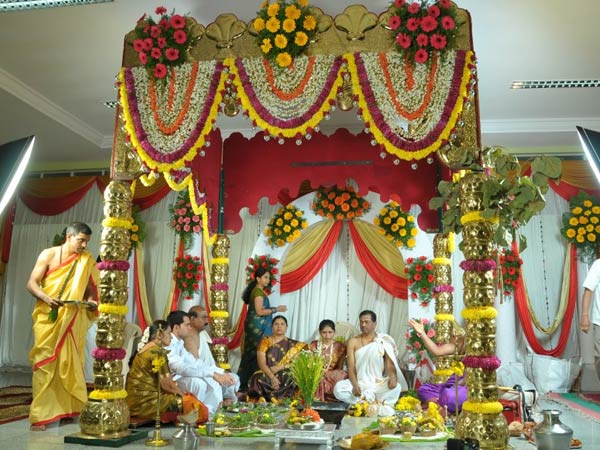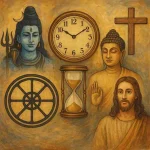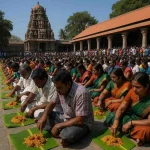Hindu weddings are getting bigger and bigger day by day . But the essential traditional rituals are still being followed in Hindu weddings. With times weddings are being now organised in wedding halls even a concept of destination wedding is also gaining momentum but the ‘lagna mandap’ still forms and occupies special place in Hindu wedding. The Mandap is also called ’manavarai’ in South India.
The mandap is a temporary four-pillar structure with a canopy that forms the sacred space for traditional Hindu weddings. Traditionally the manavarai is designed using organic pillars made of wood, bamboo, sugarcane or young banana stems.
In every Hindu Vedic traditions every ritual has a meaning. Even the mandap design and décor are rich in meanings. Here are some facts about the Mandap and its elements in a traditional Hindu wedding-
 1.Stepping into the New Phase of Life
1.Stepping into the New Phase of Life
The four pillars in a wedding mandap signifies the four stages of life as per the Hindu Vedas – Brahmacharya, Grihastha, Vanaprastha and Sanyasa. It is under this mandap that the groom steps out of his ‘Brahmacharya’ and becomes a Grihastha ,a householder. The pillars also signify the four important aspects of a human life –Dharma, Artha, Kama and Moksha, that the husband and wife swear to uphold in their life together. There are other interpretations too according to which the pillars represent the parents of the couple and the walls of the home where the newly married couple will start their new life.
2.Praying in presence of five elements
Some people believe that the mandap is the Universe under which the man and woman decide to enter marital life. At the four corners of the mandap there are stacks of pots called ‘Chori’ which are brightly decorated with velvet cloth, embroidery and stones. These symbolise the four elements – Earth, Water, Fire and Air. The fifth element the Space is represented by the ‘gopuram‘ or canopy on top.
Must Read: Flowers in Hindu Weddings: Use and Significance
3.Remembering Nature’s bounty
 In a traditional Hindu wedding you will find the excessive use of the colors of red and gold (yellow). The wedding mandap is decorated in these celebratory colors for the prosperity of the bride and groom. There are splashes of red and yellow from the flower garlands and torans, silks, turmeric and kumkum and the green from the banana leaves, betel leaves and mango leaves. The mandap is designed as such to remind the bride and groom and their family members of the happiness in nature’s bounty.
In a traditional Hindu wedding you will find the excessive use of the colors of red and gold (yellow). The wedding mandap is decorated in these celebratory colors for the prosperity of the bride and groom. There are splashes of red and yellow from the flower garlands and torans, silks, turmeric and kumkum and the green from the banana leaves, betel leaves and mango leaves. The mandap is designed as such to remind the bride and groom and their family members of the happiness in nature’s bounty.
4.Balancing the mind, body and soul
In a traditional Hindu wedding another essential element is Kalasha. A Kalasha is made of brass or silver depending on the class and social status of the families, is placed in front of the bride and groom. The kalasha is said to represent the human body. This Kalasha is filled with holy water from holy rivers like Ganga or Cauvery. According to the Hindu religion this denote that the soul that occupies the human body is ‘pure’. The kalasha is topped with a coconut that represents the head or mind of a human and is decorated with five mango leaves which represent the five senses. This kalasha is now placed on a plantain leaf covered with raw rice or paddy – a symbol of prosperity, fertility and wealth. The ‘poorna kumbam’ signifies a balance of the body, mind, soul and five senses in the bride and groom. This is important in Hindu marriages since the entire institution was centred around producing healthy progeny of sound body and mind.
5.Sacred Fire a witness to wedding
 The holy fire in a Hindu wedding is the witness or ‘saakshi’ to the marriage. According to Vedas Agni signifies purity and spirituality. Since ancient times Agni is revered as sacred , it is always invoked at the beginning of any auspicious event. In a Mandap the Vivaah-homa is raised by burning fragrant herbs, ghee, raw rice and millets. All the wedding rituals like the vows, mangalyam, saat pheras and saptapadi happen before the Agni Kund. The rituals undertaken in front of the sacred fire are believed to follow Hindu Dharma. The promises made with Agni as the saakshi also bind the man and woman in their matrimonial and societal duties.
The holy fire in a Hindu wedding is the witness or ‘saakshi’ to the marriage. According to Vedas Agni signifies purity and spirituality. Since ancient times Agni is revered as sacred , it is always invoked at the beginning of any auspicious event. In a Mandap the Vivaah-homa is raised by burning fragrant herbs, ghee, raw rice and millets. All the wedding rituals like the vows, mangalyam, saat pheras and saptapadi happen before the Agni Kund. The rituals undertaken in front of the sacred fire are believed to follow Hindu Dharma. The promises made with Agni as the saakshi also bind the man and woman in their matrimonial and societal duties.
6.Beginning a new life with abundance
The Wedding Mandap is filled with fruits, flowers, silks and gold all laid out on plates called the Thamboolam. This tradition of displaying opulence has remained unchanged from ancient times. Weddings were considered the union of two families and it makes sense that they would exhibit one another’s wealth. This display of wealth reassures the newlywed of all the blessings they have from both the families and the couple get to begin their married life in abundance.









